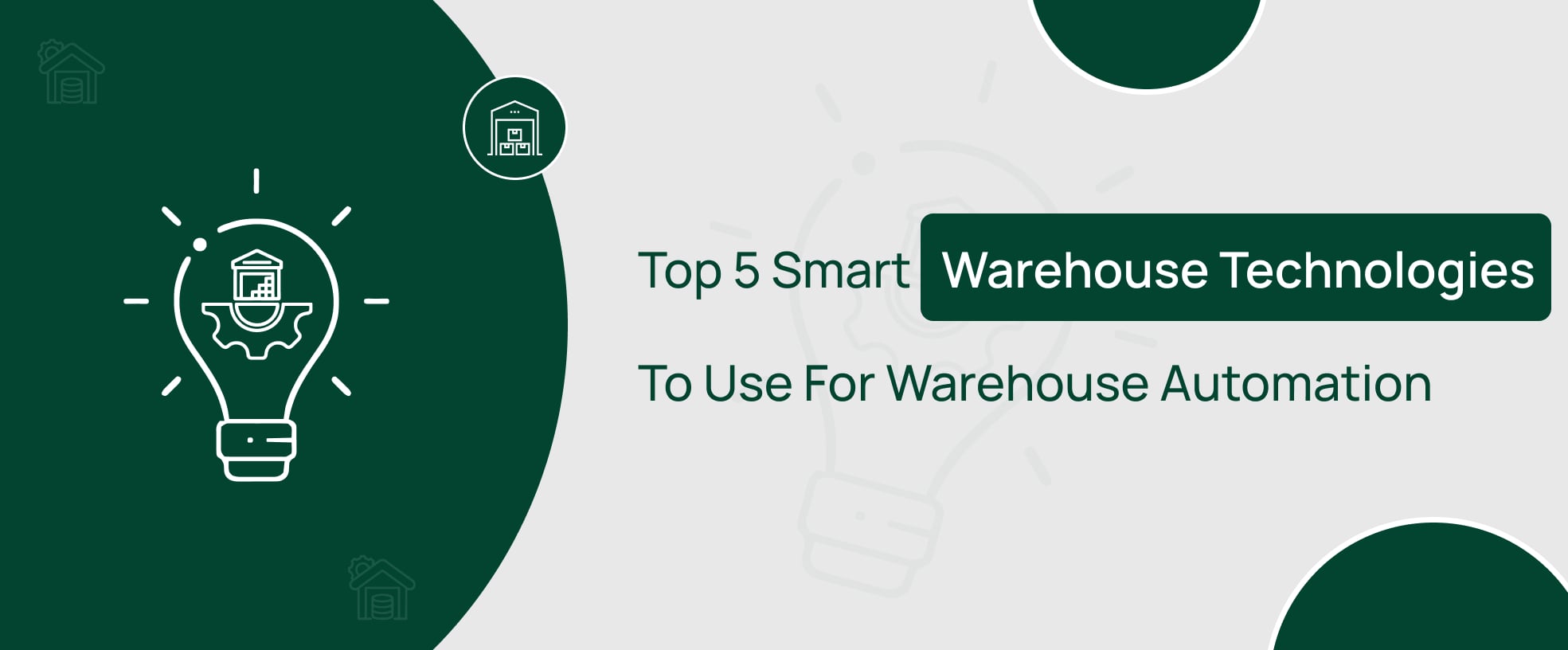Top 5 Smart Warehouse Technologies To Use For Warehouse Automation

Warehouses relying on manual processes are chaotic, difficult to manage, and have hundreds of inefficiencies. Thus, smart warehouse technologies are set to automate manual processes for better efficiency, accuracy, and productivity.
Integrating these technologies means ending all your warehouse woes. Let us check out the top 5 trending warehouse technologies that can set you apart.
A Quick Look At Key Statistics Would Amaze You!
Here are the key stats about the trend of warehouse technologies that would blow your mind.
- The adoption rate of warehouse automation technologies was just 8% in 2019. By 2030, this rate is expected to rise to 45%.(Source: Link)
- Reports from Research and Markets show that warehouse automation technology could grow up to 37.6 billion dollars by 2030.(Source: Link)
- 27% of the warehouse operators worldwide and in APAC (including India) have deployed some form of AMR (Autonomous Mobile Robots) today.(Source: Link)
Top 5 Smart Warehouse Technologies For Best Efficiency, Productivity, and Profits
Smart businesses know how to maximize their profitability. They know that maintaining and managing a warehouse is easier than ever before with the latest cutting-edge warehouse technologies. As a business dealing with logistics, you can also be ahead of others when you leverage these technologies. Here is a detailed look at the top 5.
#1 – A Warehouse Management System (WMS):
A WMS, or Warehouse Management System, is software that consolidates all important warehouse operations into a dashboard. It tackles all supply chain tasks, such as inventory management, order fulfillment, labor management, and yard management.
Warehouse management software automates all warehouse processes, from inbound receipts to deliveries, increasing efficiency and ensuring hassle-free operations. The system reduces errors in picking and shipping supplies and automates manual tasks. Here are the benefits of warehouse management software.
WMS is more like a need than a choice. It is one of the most desired warehouse technologies, handling all warehouse operations. With WMS, you can improve efficiency, have hassle-free operations, and handle high volumes. Slow, error-laden manual processes can be disastrous. Integrating WMS leads to accuracy and better productivity.
#2 – Internet of Things (IoT):
IoT, or the Internet of Things, is a technology that eases warehouse operations. It creates a network of interconnected sensors and devices that gather data to automate repetitive tasks. This technology manages and monitors the interconnected logistic operations for greater accuracy and efficiency.
IoT sensors monitor supplies’ movements, preventing theft, damage, shipping accidents, and other problems. They collect data and send real-time alerts that enable prompt action for security breaches, safety hazards, and other issues. IoT connects several digital platforms in the warehouse and ensures a continual and seamless flow of data that leads to improved decision-making.
#3 – Artificial Intelligence (AI), Machine Learning (ML), and Big Data:
Data is crucial for smooth and hassle-free warehouse operations. IoT devices generate data from the inventory, equipment, labor force activity, etc. AI in warehouse predicts and applies these data trends to optimize routes and manage resources. ML algorithms locate where the improvements are needed.
#4 – Augmented Reality (AR):
Augmented reality is a technology that adds digital elements to existing words to create a better vision. One of the latest warehouse technologies is augmented reality, which superimposes digital information on picking, packing, inventory location, etc. This leads to faster and more accurate handling of supplies.
This technology helps workers fulfill orders efficiently and track inventory loopholes. AR guidance also reduces the time it takes to pick, pack, ship, etc. Here are the benefits
#5 – Robotic Technologies:
Warehouse Automation and robotic technologies have revolutionized warehouses, increasing efficiency, accuracy, and productivity. Automated Guided Vehicles, Autonomous Mobile Robots, and Automated Sortation Systems can easily handle even the most complex warehouse tasks.
Technologies like AGVs, conveyor belts, robotics, etc., can automate all the hands-on tasks of the warehouse, such as picking, packing, labelling, and handling goods. Automation of all manual tasks leads to high efficiency and precision.
Why CommuteLogix Is The Best WMS Solution For Your Warehouse Operations?
Logistics can be complicated without robust technology. A well-chosen WMS can solve all your warehouse woes. It increases efficiency, saves costs, improves productivity, and ensures safety. However, there can be potential obstacles to getting started.
CommuteLogix is one of the best warehouse management systems, having gained immense popularity for its inventory tracking, last-mile deliveries, order and labor management, etc.
Get CommuteLogix Integrated Today!Future Trends in Warehouse Management and Automation
The cutting-edge smart warehouse technologies are all set to transform the warehouse operations. Here are a few technologies that would be future trends:
Wrapping Up
A warehouse without the integration of smart warehouse technologies is like a body without a soul. Cutting-edge technologies are transforming conservative ways of managing warehouses.
WMS, AGVs, AI, and the Internet of Things are some of the most commonly used technologies for warehouse management. Integrating them will increase the warehouse’s efficiency and productivity.
Key Takeaways:
End Your Curiosities Here!
Here are some of the most commonly asked questions about warehouse technologies.
1. What are the four types of warehouse management systems?
Standalone WMS systems, Supply chain management module, ERP (Enterprise Resource Planning Module and Cloud-based platform.
2. What are the top 5 smart technologies for warehouse management?
The top 5 smart technologies for warehouse management are WMS, IoT, automated guided vehicles, automated picking tools, robotics
3. What are the benefits of using smart warehouse technologies?
Smart technologies like WMS have several benefits. They reduce errors, reduce operational costs, increase real-time tracking, provide useful insights, and improve visibility in inventory.
4. What are the future trends for warehouse technology?
Future trends of warehouse technology include cobots, blockchain, IoT, 5G, sustainable solutions, and more.
5. What problems are solved by integrating smart technologies?
Integration of warehouse technologies like automation, AI, and IoT addresses several challenges in warehouse management. It reduces inventory errors, increases order fulfillment, and provides valuable insights that improve accuracy and efficiency.
The simplest thing to do is to integrate advanced technology to manage and automate these tasks.
Put A Full Stop To Your Warehouse Woes! Contact Us Today!
Challenges in warehouse management negatively affect efficiency and hamper progress.. Take the wise step of integrating a robust WMS into your system today. iCommuneTech is the most trusted name. Its WMS – CommuteLogix, has helped numerous logistics businesses worldwide to run profitably.
Get in touch today to be a winner!

